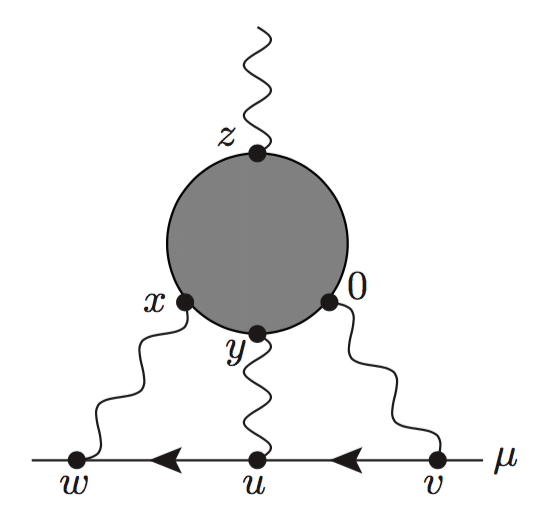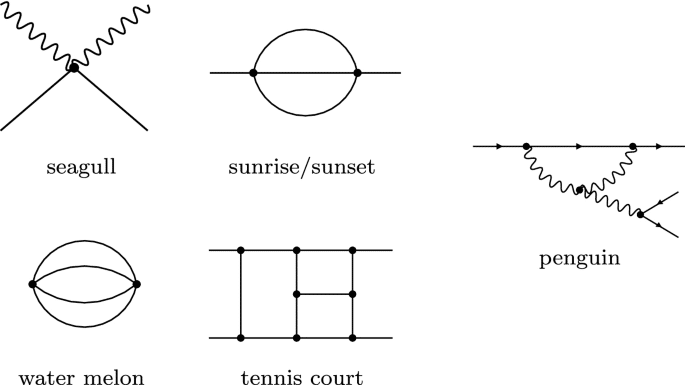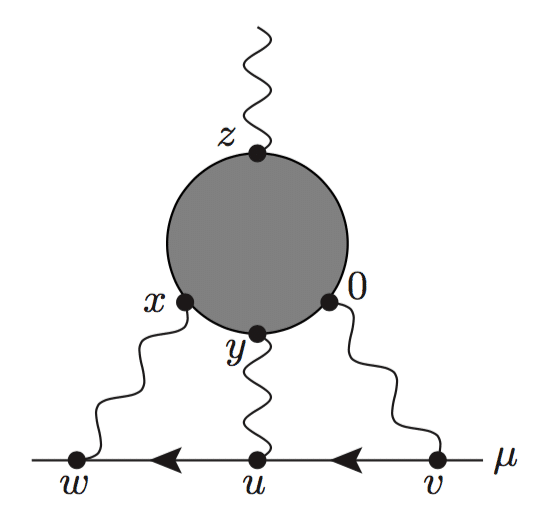
如果你也在 怎样代写量子场论Quantum field theory 这个学科遇到相关的难题,请随时右上角联系我们的24/7代写客服。商量子场论Quantum field theory是经典场论、量子力学和狭义相对论结合的结果。最早成功的经典场论是由牛顿的万有引力定律产生的,尽管在他1687年的论文《Philosophiæ Naturalis Principia Mathematica》中完全没有场的概念。牛顿所描述的引力是一种 “远距离作用”–它对远处物体的影响是瞬间的,无论距离多远。
量子场论Quantum field theory通过博恩、海森堡和帕斯卡尔-乔丹在1925-1926年的工作,自由电磁场(没有与物质相互作用的电磁场)的量子理论通过经典量子化被开发出来,将电磁场视为一组量子谐波振荡器。 然而,由于排除了相互作用,这样的理论还不能对现实世界作出定量预测。
avatest.orgt™量子场论Quantum field theory代写,免费提交作业要求, 满意后付款,成绩80\%以下全额退款,安全省心无顾虑。专业硕 博写手团队,所有订单可靠准时,保证 100% 原创。avatest.org™, 最高质量的量子场论Quantum field theory作业代写,服务覆盖北美、欧洲、澳洲等 国家。 在代写价格方面,考虑到同学们的经济条件,在保障代写质量的前提下,我们为客户提供最合理的价格。 由于作业种类很多,同时其中的大部分作业在字数上都没有具体要求,因此量子场论Quantum field theory作业代写的价格不固定。通常在经济学专家查看完作业要求之后会给出报价。作业难度和截止日期对价格也有很大的影响。
想知道您作业确定的价格吗? 免费下单以相关学科的专家能了解具体的要求之后在1-3个小时就提出价格。专家的 报价比上列的价格能便宜好几倍。
my-assignmentexpert™ 为您的留学生涯保驾护航 在物理代写方面已经树立了自己的口碑, 保证靠谱, 高质且原创的物理代写服务。我们的专家在量子场论Quantum field theory PHYS783代写方面经验极为丰富,各种量子场论Quantum field theory相关的作业也就用不着 说。
我们提供的量子场论Quantum field theory及其相关学科的代写,服务范围广, 其中包括但不限于:

物理代考|量子场论代考QUANTUM FIELD THEORY代考|Position-space Feynman rules
The Schwinger-Dyson equations specify a completely non-perturbative relationship among correlation functions in the fully interacting theory. Some non-perturbative implications will be discussed in later chapters (in particular Sections 14.8 and 19.5). In this section, we will solve the Schwinger-Dyson equations in perturbation theory.
For efficiency, we write $\delta_{x i}=\delta^4\left(x-x_i\right)$ and $D_{i j}=D_{j i}=D_F\left(x_i, x_j\right)$. We will also set $m=0$ for simplicity (the $m \neq 0$ case is a trivial generalization), and $\hbar=1$. With this notation, the Green’s function equation for the Feynman propagator can be written concisely as
$$
\square_x D_{x 1}=-i \delta_{x 1}
$$
This relation can be used to rewrite correlation functions in a suggestive form. For example, the 2-point function can be written as
$$
\left\langle\phi_1 \phi_2\right\rangle=\int d^4 x \delta_{x 1}\left\langle\phi_x \phi_2\right\rangle=i \int d^4 x\left(\square_x D_{x 1}\right)\left\langle\phi_x \phi_2\right\rangle=i \int d^4 x D_{x 1} \square_x\left\langle\phi_x \phi_2\right\rangle,
$$
where we have integrated by parts in the last step. This is suggestive because $\square_x$ acting on a correlator can be simplified with the Schwinger-Dyson equations.
Now first suppose we are in the free theory where $\mathcal{L}{\text {int }}=0$. Then the 2-point function can be evaluated using the Schwinger-Dyson equation, $\square_x\left\langle\phi_x \phi_y\right\rangle=-i \delta{x y}$, to give
$$
\left\langle\phi_1 \phi_2\right\rangle=\int d^4 x D_{x 1} \delta_{x 2}=D_{12}
$$
as expected. For a 4-point function, the expansion is similar:
$$
\begin{aligned}
\left\langle\phi_1 \phi_2 \phi_3 \phi_4\right\rangle & =i \int d^4 x D_{x 1} \square_x\left\langle\phi_x \phi_2 \phi_3 \phi_4\right\rangle \
& =\int d^4 x D_{x 1}\left{\delta_{x 2}\left\langle\phi_3 \phi_4\right\rangle+\delta_{x 3}\left\langle\phi_2 \phi_4\right\rangle+\delta_{x 4}\left\langle\phi_2 \phi_3\right\rangle\right}
\end{aligned}
$$
Collapsing the $\delta$-functions and using Eq. (7.15), this becomes
$$
\begin{aligned}
& \left\langle\phi_1 \phi_2 \phi_3 \phi_4\right\rangle=D_{12} D_{34}+D_{13} D_{24}+D_{14} D_{23} \
& =\overbrace{x_2}^{x_1}+\bullet_{x_2}^{\bullet_3} \bullet_{x_4}^{x_1}+\bullet_{x_2}^{x_3} \bullet_{x_4}^{x_1} \
&
\end{aligned}
$$
物理代考|量子场论代考QUANTUM FIELD THEORY代考|Hamiltonian derivation
In this section, we reproduce the position-space Feynman rules using time-dependent perturbation theory. Instead of assuming that the quantum field satisfies the EulerLagrange equations, we instead assume its dynamics is determined by a Hamiltonian $H$ by the Heisenberg equations of motion $i \partial_t \phi(x)=[\phi, H]$. The formal solution of this equation is
$$
\phi(\vec{x}, t)=S\left(t, t_0\right)^{\dagger} \phi(\vec{x}) S\left(t, t_0\right)
$$
where $S\left(t, t_0\right)$ is the time-evolution operator (the $S$-matrix) that satisfies
$$
i \partial_t S\left(t, t_0\right)=H(t) S\left(t, t_0\right)
$$
These are the dynamical equations in the Heisenberg picture where all the time dependence is in operators. States including the vacuum state $|\Omega\rangle$ in the Heisenberg picture are, by definition, time independent. As mentioned in Chapter 2, the Hamiltonian can either be defined at any given time as a functional of the fields $\phi(\vec{x})$ and $\pi(\vec{x})$ or equivalently as a functional of the creation and annihilation operators $a_p^{\dagger}$ and $a_p$. We will not need an explicit form of the Hamiltonian for this derivation so we just assume it is some time-dependent operator $H(t)$.
The first step in time-dependent perturbation theory is to write the Hamiltonian as
$$
H(t)=H_0+V(t)
$$
where the time evolution induced by $H_0$ can be solved exactly and $V$ is small in some sense. For example, $H_0$ could be the free Hamiltonian, which is time independent, and $V$ might be a $\phi^3$ interaction:
$$
V(t)=\int d^3 x \frac{g}{3 !} \phi(\vec{x}, t)^3
$$
The operators $\phi(\vec{x}, t), H, H_0$ and $V$ are all in the Heisenberg picture.
Next, we need to change to the interaction picture. In the interaction picture the fields evolve only with $H_0$. The interaction picture fields are just what we had been calling (and will continue to call) the free fields:
$$
\phi_0(\vec{x}, t)=e^{i H_0\left(t-t_0\right)} \phi(\vec{x}) e^{-i H_0\left(t-t_0\right)}=\int \frac{d^3 p}{(2 \pi)^3} \frac{1}{\sqrt{2 \omega_p}}\left(a_p e^{-i p x}+a_p^{\dagger} e^{i p x}\right) .
$$
To be precise, $\phi(\vec{x})$ is the Schrödinger picture field, which does not change with time. The free fields are equal to the Schrödinger picture fields and also to the Heisenberg picture fields, by definition, at a single reference time, which we call $t_0$.

量子场论代考
物理代考|量子场论代考QUANTUM FIELD THEORY代考|Position-space Feynman rules
施温格-戴森方程规定了完全相互作用理论中相关函数之间的完全非摄动关系。一些非摄动的含义将在后面的章节(特别是第14.8和19.5节)中讨论。在本节中,我们将解摄动理论中的Schwinger-Dyson方程。
为了提高效率,我们写$\delta_{x i}=\delta^4\left(x-x_i\right)$和$D_{i j}=D_{j i}=D_F\left(x_i, x_j\right)$。为了简单起见,我们还将设置$m=0$ ($m \neq 0$的情况是一个简单的泛化)和$\hbar=1$。有了这个符号,费曼传播算子的格林函数方程可以简洁地写成
$$
\square_x D_{x 1}=-i \delta_{x 1}
$$
这个关系可以用来把相关函数改写成暗示的形式。例如,两点函数可以写成
$$
\left\langle\phi_1 \phi_2\right\rangle=\int d^4 x \delta_{x 1}\left\langle\phi_x \phi_2\right\rangle=i \int d^4 x\left(\square_x D_{x 1}\right)\left\langle\phi_x \phi_2\right\rangle=i \int d^4 x D_{x 1} \square_x\left\langle\phi_x \phi_2\right\rangle,
$$
我们在上一步用分部积分法。这是有启发性的,因为$\square_x$作用于相关器可以简化为施温格-戴森方程。
首先假设我们在自由理论中$\mathcal{L}{\text {int }}=0$。然后两点函数可以用Schwinger-Dyson方程($\square_x\left\langle\phi_x \phi_y\right\rangle=-i \delta{x y}$)求值,得到
$$
\left\langle\phi_1 \phi_2\right\rangle=\int d^4 x D_{x 1} \delta_{x 2}=D_{12}
$$
不出所料。对于4点函数,展开类似:
$$
\begin{aligned}
\left\langle\phi_1 \phi_2 \phi_3 \phi_4\right\rangle & =i \int d^4 x D_{x 1} \square_x\left\langle\phi_x \phi_2 \phi_3 \phi_4\right\rangle \
& =\int d^4 x D_{x 1}\left{\delta_{x 2}\left\langle\phi_3 \phi_4\right\rangle+\delta_{x 3}\left\langle\phi_2 \phi_4\right\rangle+\delta_{x 4}\left\langle\phi_2 \phi_3\right\rangle\right}
\end{aligned}
$$
折叠$\delta$ -函数并使用公式(7.15),这变成
$$
\begin{aligned}
& \left\langle\phi_1 \phi_2 \phi_3 \phi_4\right\rangle=D_{12} D_{34}+D_{13} D_{24}+D_{14} D_{23} \
& =\overbrace{x_2}^{x_1}+\bullet_{x_2}^{\bullet_3} \bullet_{x_4}^{x_1}+\bullet_{x_2}^{x_3} \bullet_{x_4}^{x_1} \
&
\end{aligned}
$$
物理代考|量子场论代考QUANTUM FIELD THEORY代考|Hamiltonian derivation
在本节中,我们使用时变摄动理论再现位置空间费曼规则。我们不假设量子场满足欧拉拉格朗日方程,而是假设它的动力学是由哈密顿方程$H$和海森堡运动方程$i \partial_t \phi(x)=[\phi, H]$决定的。这个方程的形式解是
$$
\phi(\vec{x}, t)=S\left(t, t_0\right)^{\dagger} \phi(\vec{x}) S\left(t, t_0\right)
$$
哪里$S\left(t, t_0\right)$是时间演化算子($S$ -矩阵),满足
$$
i \partial_t S\left(t, t_0\right)=H(t) S\left(t, t_0\right)
$$
这些是海森堡图中的动力学方程所有的时间依赖都在算符中。根据定义,包括海森堡图像中的真空状态$|\Omega\rangle$在内的状态是与时间无关的。如第二章所述,哈密顿量可以在任何给定时间定义为场$\phi(\vec{x})$和$\pi(\vec{x})$的泛函,或者等价地定义为产生和湮灭算子$a_p^{\dagger}$和$a_p$的泛函。我们不需要哈密顿函数的显式形式来推导所以我们假设它是一个与时间相关的算子$H(t)$。
时间相关微扰理论的第一步是把哈密顿量写成
$$
H(t)=H_0+V(t)
$$
其中$H_0$引起的时间演化可以精确求解,且$V$在某种意义上较小。例如,$H_0$可能是自由哈密顿量,它是时间无关的,$V$可能是$\phi^3$交互:
$$
V(t)=\int d^3 x \frac{g}{3 !} \phi(\vec{x}, t)^3
$$
操作符$\phi(\vec{x}, t), H, H_0$和$V$都在海森堡的图像中。
接下来,我们需要切换到交互图片。在相互作用图中,场只随着$H_0$的变化而变化。交互图字段就是我们一直称之为(并将继续称之为)自由字段的字段:
$$
\phi_0(\vec{x}, t)=e^{i H_0\left(t-t_0\right)} \phi(\vec{x}) e^{-i H_0\left(t-t_0\right)}=\int \frac{d^3 p}{(2 \pi)^3} \frac{1}{\sqrt{2 \omega_p}}\left(a_p e^{-i p x}+a_p^{\dagger} e^{i p x}\right) .
$$
准确地说,$\phi(\vec{x})$是Schrödinger图片字段,它不随时间变化。自由场等于Schrödinger图像场也等于海森堡图像场,根据定义,在一个参考时间,我们叫它$t_0$。

物理代考|量子场论代考QUANTUM FIELD THEORY代考 请认准UprivateTA™. UprivateTA™为您的留学生涯保驾护航。
微观经济学代写
微观经济学是主流经济学的一个分支,研究个人和企业在做出有关稀缺资源分配的决策时的行为以及这些个人和企业之间的相互作用。my-assignmentexpert™ 为您的留学生涯保驾护航 在数学Mathematics作业代写方面已经树立了自己的口碑, 保证靠谱, 高质且原创的数学Mathematics代写服务。我们的专家在图论代写Graph Theory代写方面经验极为丰富,各种图论代写Graph Theory相关的作业也就用不着 说。
线性代数代写
线性代数是数学的一个分支,涉及线性方程,如:线性图,如:以及它们在向量空间和通过矩阵的表示。线性代数是几乎所有数学领域的核心。
博弈论代写
现代博弈论始于约翰-冯-诺伊曼(John von Neumann)提出的两人零和博弈中的混合策略均衡的观点及其证明。冯-诺依曼的原始证明使用了关于连续映射到紧凑凸集的布劳威尔定点定理,这成为博弈论和数学经济学的标准方法。在他的论文之后,1944年,他与奥斯卡-莫根斯特恩(Oskar Morgenstern)共同撰写了《游戏和经济行为理论》一书,该书考虑了几个参与者的合作游戏。这本书的第二版提供了预期效用的公理理论,使数理统计学家和经济学家能够处理不确定性下的决策。
微积分代写
微积分,最初被称为无穷小微积分或 “无穷小的微积分”,是对连续变化的数学研究,就像几何学是对形状的研究,而代数是对算术运算的概括研究一样。
它有两个主要分支,微分和积分;微分涉及瞬时变化率和曲线的斜率,而积分涉及数量的累积,以及曲线下或曲线之间的面积。这两个分支通过微积分的基本定理相互联系,它们利用了无限序列和无限级数收敛到一个明确定义的极限的基本概念 。
计量经济学代写
什么是计量经济学?
计量经济学是统计学和数学模型的定量应用,使用数据来发展理论或测试经济学中的现有假设,并根据历史数据预测未来趋势。它对现实世界的数据进行统计试验,然后将结果与被测试的理论进行比较和对比。
根据你是对测试现有理论感兴趣,还是对利用现有数据在这些观察的基础上提出新的假设感兴趣,计量经济学可以细分为两大类:理论和应用。那些经常从事这种实践的人通常被称为计量经济学家。
MATLAB代写
MATLAB 是一种用于技术计算的高性能语言。它将计算、可视化和编程集成在一个易于使用的环境中,其中问题和解决方案以熟悉的数学符号表示。典型用途包括:数学和计算算法开发建模、仿真和原型制作数据分析、探索和可视化科学和工程图形应用程序开发,包括图形用户界面构建MATLAB 是一个交互式系统,其基本数据元素是一个不需要维度的数组。这使您可以解决许多技术计算问题,尤其是那些具有矩阵和向量公式的问题,而只需用 C 或 Fortran 等标量非交互式语言编写程序所需的时间的一小部分。MATLAB 名称代表矩阵实验室。MATLAB 最初的编写目的是提供对由 LINPACK 和 EISPACK 项目开发的矩阵软件的轻松访问,这两个项目共同代表了矩阵计算软件的最新技术。MATLAB 经过多年的发展,得到了许多用户的投入。在大学环境中,它是数学、工程和科学入门和高级课程的标准教学工具。在工业领域,MATLAB 是高效研究、开发和分析的首选工具。MATLAB 具有一系列称为工具箱的特定于应用程序的解决方案。对于大多数 MATLAB 用户来说非常重要,工具箱允许您学习和应用专业技术。工具箱是 MATLAB 函数(M 文件)的综合集合,可扩展 MATLAB 环境以解决特定类别的问题。可用工具箱的领域包括信号处理、控制系统、神经网络、模糊逻辑、小波、仿真等。